What Is Ghee? Healthier than Butter?
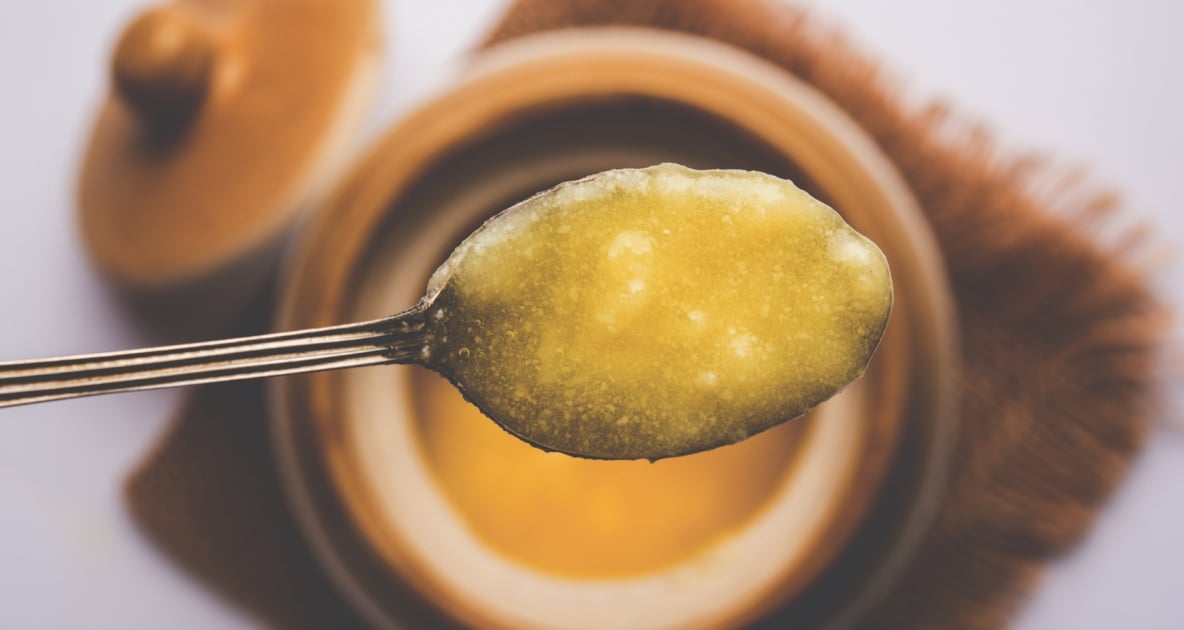
Ghee, very simply, is culinary liquid magic. It makes everything it touches taste buttery and delicious. Why? Because it’s made from butter, taken to its purest and most refined state.
Ghee is a Hindi word (be sure to pronounce the “H” a bit, it’s not silent), and because of that it evokes images of exotic Indian curries and fried snacks. However, this golden substance has actually been an important ingredient in fine European cuisine for centuries.
What Is Ghee?
Gee is nothing more than the pure butterfat extracted from milk. Dairy butter, a.k.a. “sweet cream butter,” is an intermediate stage of refinement on the way to total butterfat extraction. A stick of butter has a high percentage of butterfat, but includes some additional water and impurities, whereas ghee is pure, 100% unadulterated butterfat. You’ll often hear it referred to as clarified butter or butter oil.
How Is Ghee Made?
Technically, ghee can be made with most any milk, including that of goats, sheep, or buffalo, but in countries like the U.S., with large dairy industries, the butter inevitably begins with cow’s milk. Ghee made from cow’s milk accounts for most of the ghee used in cooking in the modern world.
The history of ghee goes back as far as the domestication of cattle itself, where the consumption of dairy products and butter in the human diet began.
While butter is undeniably delicious, it is also perishable. It contains milk solids, which can spoil. When cooking with butter, those milk solids can turn brown, and eventually burn and become bitter and ruin a dish if you’re not careful.
If you’ve ever melted butter, you’ve seen it separate into a clear, golden oil interspersed with whitish milk solids. Some of these solids foam and rise to the top, while others settle to the bottom. Oil is lighter than water, and the impurities in butter are mostly water with a few trace proteins like casein and sugars, such as lactose.
The clear golden oil that separates from the solids is ghee. It’s far more stable and less perishable than dairy butter. It doesn’t require refrigeration. It’s a soft solid at room temperature; in warmer climates, it remains a golden liquid oil.
If you had never heard of ghee before, you may recall it being mentioned recently in the news: after the devastating Nepal earthquake, a teenage boy was pulled from the rubble after being trapped for five days. When asked how he survived with no food or water, he told reporters he actually survived by eating ghee.
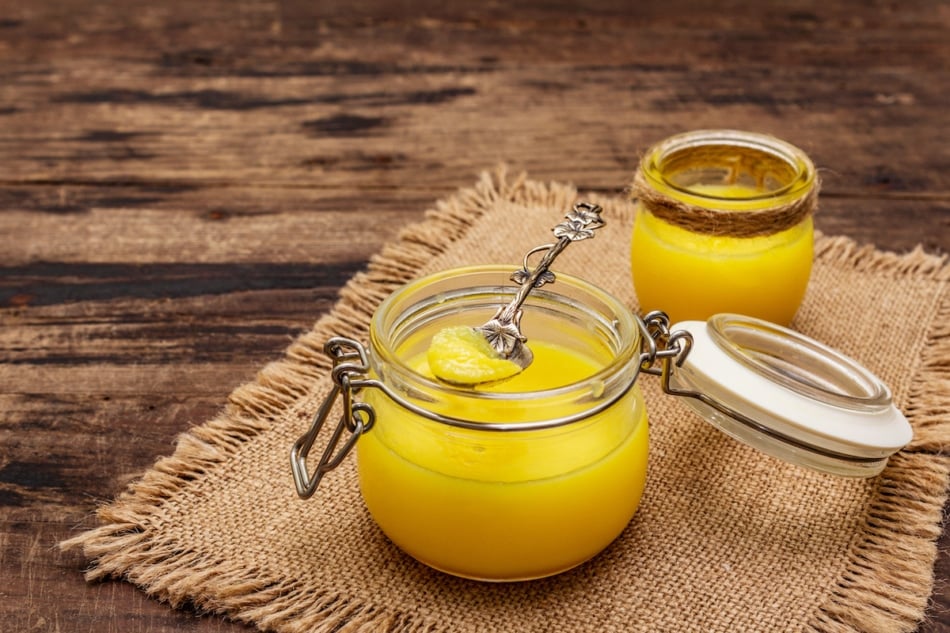
What Are The Advantages of Cooking With Ghee?
The advantages of cooking with ghee are many. The first is flavor. Ghee has a slightly nutty, almost butterscotch-like flavor. The next advantage is that ghee withstands heat very well. It has a high smoke point, meaning that it can be heated to a higher temperature before breaking down and smoking or scorching. The smoke point of ghee is a whopping 485° F. About 150° higher than butter which has not been clarified.
This high smoke point makes ghee perfect for browning or pan searing any protein, or other foods where you want to develop a golden brown crust. Something chefs call the Maillard reaction. If you’ve had beautifully seared fish, scallops, or chops in a restaurant, where there was a delicious golden brown crust surrounding a perfectly cooked interior, it was probably pan-seared in clarified butter.
Indian chefs use ghee to develop flavor in curries, because certain spices best release their essential oils when fried at higher temperatures. Many Indian preparations begin with mustard and cumin seeds added to hot ghee until they pop and crackle. Onions, also a primary ingredient in many Indian gravies, caramelize beautifully in ghee.
Ghee is also terrific for frying. Potatoes fried in it are crisp and sublime. The reason most people don’t deep fry with pure ghee is that it tends to be somewhat expensive, and a little goes a long way. Many restaurant chefs keep it in a squeeze bottle for anything that needs a quick sauté.
What About Saturated Fat?
There tends to be an avoidance of saturated fats like butter for health reasons. However, those attitudes are starting to change, and many cooks are going back to natural saturated fats, which lend great flavor to food, while avoiding hydrogenated trans-fats, like shortening. Ancient Ayurvedic medicine has mentioned the health benefits of ghee in Indian culture for thousands of years.
What If I’m Lactose Intolerant?
People who are lactose intolerant or dairy sensitive have no problems with ghee. Healthline says, “Because ghee separates milk from fat, this butter substitute is lactose-free, making it better than butter if you have allergies or sensitivities to dairy products.”
Where Can You Buy Ghee?
You can buy it online, in many Asian markets, trendy health food stores, and even in many big name supermarkets, however, store bought versions are expensive. On average, an 8 oz. jar can cost upwards of $10. Luckily, ghee is easy and inexpensive to make easy to make, but you need to have patience. Here’s how:
Ghee Recipe
Ingredients:
- 2 lbs. unsalted butter
- Cheesecloth or food grade muslin
Instructions:
- Heat the butter on medium in a heavy-bottomed stainless steel saucepan (or a white-enameled Dutch oven works well). When the butter is fully melted, continue to cook until it starts to foam. As the foam forms on the top, skim it off. The best tool for the job is a skimmer, a shallow flat ladle with holes in it. (You can actually save the skimmed foam, refrigerate, and spread on your toast. It’s just like butter, but with less fat!).
- After most of the foam is removed, continue to slow simmer the butter on low, watching it carefully. Resist the urge to increase the temperature and hurry the process — be patient! Let time and heat do the work. If you need something to do, keep skimming the surface every so often. As the water is cooking off, the butter will go from cloudy to clear; the heavier milk solids begin separating, cooking, and sinking to the bottom of the pan.
- The ghee is done when the oil is perfectly clear, beautifully golden yellow, and the solids at the bottom just begin to look granular and begin to lightly toast and turn a light brown color. It’s very important to take the pan off the heat before those solids get too dark. Think of a very lightly toasted marshmallow as opposed to letting it catch fire and blacken.
- Next, remove the pan from the heat. Place several layers of cheesecloth in a wire mesh strainer set over a bowl. Pour the ghee into the cheesecloth to strain all the solids.
- Two pounds of butter should yield about 24 oz. of ghee. Higher quality butter will give you more ghee per pound, because it will have fewer impurities. Allow the ghee to cool slightly, then pour into a clean jar. No need to refrigerate.
Enjoy this classic, flavorful Indian dish (which is now the new national dish of the U.K.) made with ghee.
Chicken Tikka Masala Recipe
Ingredients:
- 6 garlic cloves, finely grated
- 4 tsp finely grated peeled ginger
- 4 tsp ground turmeric
- 2 tsp garam masala (a spice blend, available at most health food stores in bulk)
- 2 tsp ground coriander
- 2 tsp ground cumin
- 1 1/2 cups whole-milk yogurt (not Greek)
- 1 Tbsp kosher salt
- 2 pounds skinless, boneless chicken breasts, halved lengthwise
- 3 Tbsp ghee
- 1 small onion, thinly sliced
- 1/4 cup tomato paste
- 1 cup tomato paste
- 6 cardamom pods, crushed
- 2 dried chiles de árbol or 1/2 teaspoon crushed red pepper flakes (optional)
- 1 can whole peeled tomatoes (28-ounce)
- 2 cups heavy cream
- 3/4 cup chopped fresh cilantro, plus some for garnish
- Steamed basmati rice
Instructions:
- Combine garlic, ginger, turmeric, garam masala, coriander, and cumin in a small bowl. Whisk yogurt, salt, and half of spice mixture in a medium bowl; add chicken and turn to coat. Cover and chill 4-6 hours. Cover and chill remaining spice mixture.
- Heat ghee in a large, heavy pot over medium heat. Add onion, tomato paste, cardamom, and chiles and cook, stirring often, until tomato paste has darkened and onion is soft, about 5 minutes. Add remaining half of spice mixture and cook, stirring often, until bottom of pot begins to brown, approximately 4 minutes.
- Add tomatoes with juice, mashing them with your hands as you add them. Bring mixture to a boil, then reduce heat, and simmer, stirring often and scraping up browned bits from bottom of pot, until sauce thickens, 8-10 minutes.
- Add cream and chopped cilantro. Simmer gently, stirring occasionally, until sauce thickens, 30-40 minutes.
- Meanwhile, preheat broiler. Line a rimmed baking sheet with foil and set a wire rack inside sheet. Arrange chicken on rack in a single layer. Broil until chicken starts to blacken in spots (it will not be cooked through), about 10 minutes.
- Cut chicken into bite-size pieces and add to the sauce, and simmer, stirring occasionally, until chicken is cooked through, 10-12 minutes. Top with chopped cilantro and serve with cooked Basmati rice and warm Naan (bread).
Join the Discussion!
Have you ever made ghee butter before?
Share your experience and tips in the comments!

Edward Higgins
Edward Higgins is a freelance writer, artist, home chef, and avid fly fisherman who lives outside of Portland, Maine. He studied at Skidmore College and Harvard University. His article 10 Best Edible Insects appears in the 2020 Farmers' Almanac.



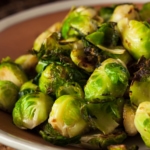
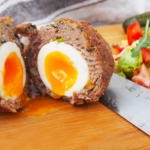
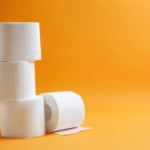
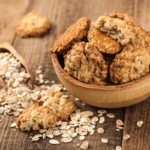
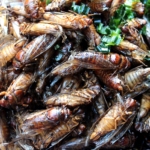
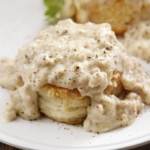

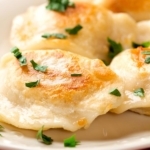
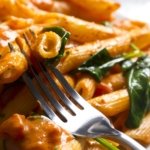
Ghee is indeed a nourishing dairy oil but the process, how is ghee made regulates the quality of the ghee. It is wise to use grass-fed ghee made in a pollution-free place like New Zealand, where you can be sure that the ghee you are using does not contain any nasties like carbs, sugar, GMOs in your diet.
https://milkio.co.nz/how-is-ghee-made/
My grandchildren are Dutch kids and they love to eat ghee with cooked rice and lentils (moong dhal or thuvar dhal well cooked with a little turmeric powder) and then seasoned with cumin seeds and pepper powder. This is their favourite dish!
Seasoning is done by heating a tablespoon of ghee to which a 1/4 tsp of cumin seeds is added with a little pepper powder. When the cumin gets brown, it is tossed on the rice and lentil mixture. Salt is added to complete the dish. To enhance the taste we can add fresh coriander leaves too and 1 or 2 tablespoons of extra ghee. When cooking the moong lentil on the stove, it should be cooked on moderate heat with enough water and not be covered fully as it tends to froth and spillover. Cooking in a pressure cooker solves the problem. The lentils should be in a stainless steel vessel inside with a lid so that it does not spread all over the cooker. Even plain soft rice with ghee and salt tastes good. We give it to the babies too when they start on solids but without salt.
I use Ghee on my face for wrinkles and have nice smooth skin now.
We hadn’t heard of that! But I suppose it would keep skin nice and moisturized.
Thank you also for this article! Very educational and intriguing. Thanks for sharing your knowledge, can’t wait to try the recipe!
Thank you for the article. It “clarified” a lot of things for me. My relatives used to melt the store bought butter over the heat and add a handful of burghul or cracked wheat to it and leave until cool. During the time it is left to cool, the burghul would soak up all the impurities of the butter settling in the bottom of the pot. There you have it: ghee. You then remove the butter, now ghee by pouring it slowly into a jar and discard the soaked burghul. For a long time I had wondered what ghee was and all this time I have been using it by following what the elders of my family did for years. Thanks again. Marie
I use ghee and organic coconut oil to make “bulletproof coffee”. It energizes without giving jitters. I’ve seen recipes that say to put 1T of each in a cup of coffee, but I only use 1 tsp of each. Love it!
I had a large jar of ghee and had plans to use it in my healthy cooking. BUT I can not tolerate the smell…it smells rancid to me. I went back to the Indian store where I bought it from and he says this is the normal smell of ghee. He even opened another jar from off the shelf to prove it and said this is how it normally smells. My mom had always used ghee in her cooking so I gave it to her and she loves it. Any thoughts to this rancid smell or is it only me?
Hi Ali, I spoke with Ed Higgins and he says, “Anything that smells rancid to you is not acceptable, even if the store owner says it’s fine. Rancid is a very distinct smell and there’s no denying what it is. There are hundreds of brands of ghee out there, maybe try to find another jar or brand that’s made locally if you don’t want to make your own. Good luck!”
interesting article. thanks for the info. I have some ghee in my refrigerator that my husband bought and I have no idea what to do with it.
Very informative article and what a wonderful recipe! I learned to prepare ghee from a lovely Austrailian-Indian lady whilst at University of Texas and we were all living at Married Student Housing. It was very useful and tasty in those never ending summers!
Jenn